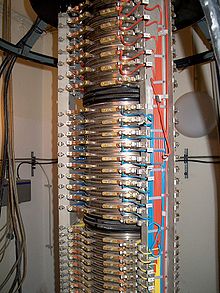Sliding contact

Sliding contacts establish an electrical connection to moving parts. Examples are the carbon brushes and commutators of motors, current collectors ( contact strip / overhead line ), slip ring systems or rotary switches and potentiometers .
Like sliding bearings, sliding or sliding contacts always consist of two materials of different hardness. In the case of high powers and voltages, the pairing copper / graphite is usually used, while precious metals are also used for very low powers and signal transmissions.
Rotary switches for signaling purposes use materials such as brass , copper or also silver , palladium and gold ; With these, the focus is not on wear, but on good contact and a low contact resistance.
The macroscopic and microscopic processes on a sliding contact with and without a current flow are fundamentally different. Electromigration plays a role , particularly with direct current and metal / metal pairings .
history
In 1833 William Ritchie built a machine in which springs made of copper were used as a power transmission element. In 1884 a patent appeared in which brush brushes were mentioned. This form of sliding contact was also the godfather for the name of this component, which is still used all over the world today - carbon brush .
However, it was soon recognized that copper as a sliding contact material has a poor service life. Strong sparking causes high wear of both the contact brushes and the commutator .
In 1885, Professor George Forbes published a patent proposing carbon to transmit electricity in sliding contacts.
However, it took until the beginning of the 20th century for this idea to be implemented commercially. At the latest with the development of electric railways , the era of copper brush brushes ended. The economic development of important industrial sectors such as steel or mining, or of global companies such as Siemens, AEG, BBC would not have been possible without electrical drives with carbon brushes as sliding contact.
Carbon brushes are mainly used in electric motors (so-called universal motors , e.g. in washing machines, vacuum cleaners, electrical handheld devices), but also on gantry cranes, Ferris wheels, carousels, etc. With pantographs of electric railways they are called contact strips , with potentiometers they are called sliders .
Small direct current electric motors in CD players , cassette tape recorders or similar. on the other hand often have precious metal brushes.
Advantages and disadvantages of graphite
Graphite has the following advantages over metallic sliding materials:
- electrical conductivity increasing with temperature
- low friction due to the layered arrangement of the crystal planes of graphite
- no melting, therefore no tendency to weld with the opposing material
- low density
- environmentally friendly
- good chemical resistance
The disadvantage is the semiconducting property of graphite, this causes a certain voltage drop even with small currents, but this does not increase significantly with higher currents. This prevents the use of graphite sliding contacts for very low voltages or for measuring purposes. In potentiometers for angle measurement, in acceleration or pressure sensors as well as in small DC motors with low operating voltage, precious metal sliding contacts are used.
Carbon brushes on motors form a so-called patina on the copper collector or grinding partner . This dark brown layer is not a defect or an impurity, but the color is characteristic of the good condition of a collector or slip ring. If, on the other hand, it is partially black, this indicates excessive brush fire or partially lifted brushes.
Graphite sliding contacts: manufacture and requirements
The production of carbon brushes or graphite sliding contact pieces begins with the selection and processing of the raw materials: In addition to natural graphite, artificial graphite, coke , carbon black and pitch are used. After mixing the components and shaping processes, a fire takes place at up to 3000 ° C, which plays an important role in setting the properties of the end products. Post-treatments such as impregnation with resins or the addition of metal components allow further modification. Removal processing steps then give the components their final contour. See also carbon brush .
Temperature, current , air humidity , counter-rotating material, contact pressure and ambient conditions are the most important parameters that influence the running behavior of electrical sliding contacts.
Areas of application for electrical sliding contacts
The most important areas of application are:
- stationary direct current drives from a few watts to a few megawatts
- Railway traction motors in long-distance and local traffic,
- Slip-ring motors and generators , e.g. B. power plants or wind turbines,
- Low-voltage motors, including actuators on machines and motor vehicles (e.g. fans, windshield wipers)
- Small and micro motors in household appliances and audio and video recording and playback devices
- Collectors for electric rail vehicles
- Sliding contacts for moving electricity consumers (gantry cranes, carousels, etc.)
- Potentiometers , sliders, angle sensors, acceleration sensors, incremental encoders
